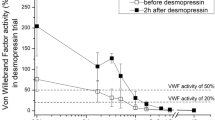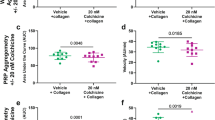Abstract
Blood platelets have a major role in haemostasis through their aggregation and adherence to the damaged vessel wall. During this process, platelet granular constituents are released. Although the functions of many of these release products are well known, biological functions of some well defined platelet specific proteins have not been determined. This category includes platelet factor 4 (PF4) and β-thromboglobulin (βTG), both small proteins of molecular weight 30,000–36,000 (refs 1, 2) which are stored in the α granule of the platelet and have not been detected in any other tissue. βTG is composed of four identical noncovalently bound subunits and its amino acid sequence is significantly homologous with that of PF4 (ref. 3). Although PF4 possesses a marked ability to neutralise heparin, no physiological or pathophysiological role has been attributed to either protein. The discovery of prostacyclin (PGI2) has led to a reappraisal of the factors regulating haemostasis and especially of the role of the vascular endothelium in preventing platelet adherence and aggregation4–6. The initial action of PGI2 on the platelet is to stimulate adenylate cyclase7–9, and it is the most potent inhibitor of platelet aggregation yet discovered. Also, cultures of arterial and venous endothelial cells have been found capable of producing PGI2 (refs 10,11). We now report results indicating that βTG reduces the production of PGI2-like activity in cultured bovine endothelial cells, which are shown to possess a specific receptor for βTG. The characteristics of this receptor suggest that βTG may act locally at high concentrations to favour platelet aggregation by diminishing PGI2 production.
This is a preview of subscription content, access via your institution
Access options
Subscribe to this journal
Receive 51 print issues and online access
$199.00 per year
only $3.90 per issue
Buy this article
- Purchase on Springer Link
- Instant access to full article PDF
Prices may be subject to local taxes which are calculated during checkout
Similar content being viewed by others
References
Moore, S., Pepper, D. S. & Cash, J. D. Biochim. biophys. Acta 379, 360–369, 370–384 (1975).
Moore, S. & Pepper, D. S. in Platelets in Biology and Pathology (ed. Gordon, J. L.) 293 (North-Holland, Amsterdam, 1977).
Begg, G. S., Pepper, D. S., Chesterman, C. N. & Morgan, F. J. Biochemistry 17, 1739–1744 (1978).
Moncada, S., Gryglewski, R., Bunting, S. & Vane, J. R. Nature 263, 663–665 (1976).
Gryglewski, R. J., Bunting, S., Moncada, S., Flower, R. J. & Vane, J. R. Prostaglandins 12, 685–713 (1976).
Bunting, S., Gryglewski, R., Moncada, S. & Vane, J. R. Prostaglandins 12, 897–913 (1976).
Best, L. C., Martin, T. J., Russell, R. G. G. & Preston, F. E. Nature 267, 850–852 (1977).
Gorman, R. R., Bunting, S. & Miller, O. V. Prostaglandins 13, 377–388 (1977).
Tateson, J. E., Moncada, S. & Vane, J. R. Prostaglandins 13, 389–397 (1977).
Baenziger, N. L., Dillender, M. J. & Majerus, P. W. Biochem. biophys. Res. Commun. 78, 294–301 (1977).
Weksler, B. B., Marcus, A. J. & Jaffe, E. A. Proc. natn. Acad. Sci. U.S.A. 74, 3922–3926 (1977).
Gimbrone, M. A., Cotran, R. S. & Folkman, J. J. Cell Biol. 60, 673–684 (1974).
Ludlam, C. A., Moore, S., Bolton, A. E., Pepper, D. S. & Cash, J. E. Thromb. Res. 6, 543–548 (1975).
Canfield, R. E., Kammerman, S., Sobel, J. H. & Morgan, F. J. Nature new Biol. 232, 16–17 (1971).
MacIntyre, D. E., Pearson, J. D. & Gordon, J. L. Nature 271, 549–551 (1978).
Weksler, B. B., Ley, C. W. & Jaffe, E. W. J. clin. Invest. 62, 923–930 (1978).
Nordøy, A., Svensson, B., Wiebe, D. & Hoak, J. C. Circulation Res. 43, 527–534 (1978).
Rucinski, B., Niewiarowski, S., Pranee, J., Walz, D. A. & Budzynski, A. Z. Blood 43, 47–62 (1979).
Morgan, F. J., Chesterman, C. N., McGready, J. R. & Begg, G. S. Haemostasis 6, 53–58 (1977).
Chesterman, C. N., McGready, J. R., Doyle, D. J. & Morgan, F. J. Br. J. Haemat. 40, 489–500 (1978).
Rodbard, D. Clin. Chem. 20, 1255–1270 (1974).
Author information
Authors and Affiliations
Rights and permissions
About this article
Cite this article
Hope, W., Martin, T., Chesterman, C. et al. Human β-thromboglobulin inhibits PGI2 production and binds to a specific site in bovine aortic endothelial cells. Nature 282, 210–212 (1979). https://doi.org/10.1038/282210a0
Received:
Accepted:
Issue Date:
DOI: https://doi.org/10.1038/282210a0
This article is cited by
-
Intravascular platelet activation in the hemolytic uremic syndrome
Kidney International (1988)
-
Hemolytic uremic syndrome
The Indian Journal of Pediatrics (1987)
-
γ-Interferon transcriptionally regulates an early-response gene containing homology to platelet proteins
Nature (1985)
-
Thrombotisch-thrombozytopenische Purpura
Klinische Wochenschrift (1985)
-
Studies on endothelial cell cytotoxic activity in sera of patients with progressive systemic sclerosis, Raynaud syndrome, rheumatoid arthritis, and systemic lupus erythematosus
Rheumatology International (1985)
Comments
By submitting a comment you agree to abide by our Terms and Community Guidelines. If you find something abusive or that does not comply with our terms or guidelines please flag it as inappropriate.



